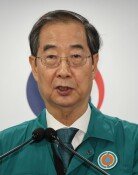Goguryeo Comes to Seoul
North Koreas national treasure-class Goguryeo artifacts have arrived in Seoul.
Sixty Goguryeo artifacts, including 15 national treasure-class artifacts belonging to the Chosun Central History Museum, reached Seoul via a Kumgang Mountain tourism course (road number seven) on April 22. These relics will be exhibited in a Special Goguryeo Exhibition (running from May 7 to July 10) celebrating Korea Universitys centennial anniversary
Korea University Museum curator Choi Gwang-sik (Korea University Korean history professor) led the Goguryeo artifact reception team of six and visited Kumgang Mountain on Apr 21. His team received the artifacts from Chosun Central History Museum curator Kim Song Hyun and loaded them into shock-proof special vehicles, passed through Kangwon Kosung-gun Unification Towers customs, immigration and quarantine office in the afternoon, and finally arrived in Seoul late at night.
Among the artifacts brought in that day, there are various national treasure-class artifacts that were unknown to South Korea, including a gold-coated copper plaque with carved letters (made in 546) excavated in Ohmaeri, Shinpo-si, Hamgyungnam-do, in 1988, and an iron horse and bronze Sashin (four animals that represent the four directions), presumed to date back to the 3rd Century, that was found in Gangwon-do Chulryung, in 1994.
In addition to Goguryeos most typical metal artifacts -- flaring-sun pattern gold-coated copper ornaments and flaring-spark pattern cold-coated copper crowns -- diverse roof tiles and bricks excavated from Pyongyangs Anak Palace and Chungreung Temple site, trumpet shaped pots, harnesses from Pyongananam-do Pyongsung-Si Jigyung-dong Number One Tomb, a burial pot, and a statue from Pyongyangs Daesung Mountain are some of the artifacts brought to Seoul.
The estimated value of all the artifacts brought to Seoul is about $34.03 million (about 34 billion won).
Professor Choi said, Goguryeo artifacts have been displayed in Seoul twice, once in late 2002 and once in March 2004 with the help of the KCRC (Korea Council for Reconciliation and Cooperation), but most of them were restored wall paintings. This time, the artifacts are genuine artifacts that will make you feel the essence of Goguryeo culture.
Furthermore, unlike the past two times when North Korean relics were transported by sea from Nampo to Incehon port, this time land transportation was used. Korea University will display a total of 230 Goguryeo artifacts -- 80 South Korean Goguryeo artifacts and 40 Goguryeo artifacts borrowed from Japan in addition to North Korean artifacts -- in Ilmin Museum inside Korea University under the title: Korean ancient times Global Pride: Goguryeo starting May 7. This special exhibition is under the joint auspices of Korea University Museum and City of Seoul, and is sponsored by Dong-a Ilbo, the Korea Central Foundation, the Goguryeo Research Foundation, the South-North History Scholar Council and the Korean Association of University Museums.
klimt@donga.com







